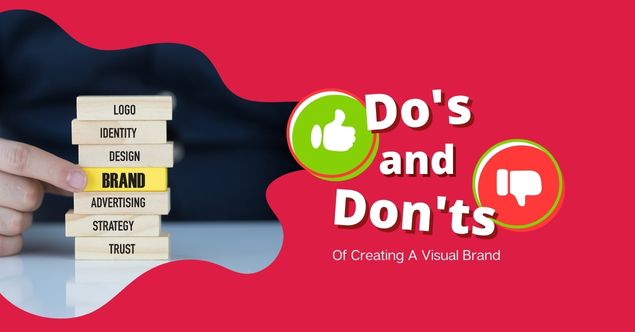Designing for visual impact takes more than just aesthetic appeal. To create an iconic brand that resonates with audiences, we need to understand the principles of visual communication.
A great visual brand is consistent, and emotive, images, logos, and design photos that you use to promote your business do your visual brand in the market based on an understanding of your target audience.
You may not realize it, but your visual brand tells the story and journey of your business, including your company’s values, core, personality and purpose. It can be one of the best marketing tools you can use for communicating with your customers.
Meticulously craft messages to express values and ideas in ways that are both visually stunning and emotionally gripping. Focus on every detail, pick color palettes and font styles carefully, as design decisions should be anchored in a solid concept driven by a clear purpose.
Vividly illustrate stories to connect with viewers by creating meaningful symbols that tell a memorable story. Put yourself in your customer's shoes: when perusing visuals, they should experience something fresh and original that leaves them feeling informed and inspired.
However, try not to overthink things: keep the vibe light-hearted rather than overly serious or corporate so that it’s easy for potential customers to relate to the message you’re conveying.
Always push boundaries but don’t go over the top – too much complexity can distract people from your core values or perspective, reducing the overall effect of any campaign.
Poor visual branding, however, can affect and hurt your business image. Business owners who are interested in developing their own visual brand should read this article.
Visual Branding
Visual branding is an important element of your marketing strategy. It consists of all the visual elements used to represent your business in the market, from your logo, and images to the font on your business cards. Each element works together to create the overall look and feel of your business image.
It's important for every business to convey its brand personality and make an emotional impression on its audience. Finally, your visual branding approach will help unite the many fragments of your brand through consistent images, design and fonts, etc.
Whether your target customer looks at an email newsletter, Instagram post or brochure, shared visual branding elements will signal that it’s your business that is different from others.
The Visual Branding Process
Effective your brand personality and how it relates to your business goals, aims and values.
Conduct market research to understand your market competitors’ visual branding approaches and what your target audience will be looking for.
Gather inspiration and collect visual images, and design references through mood boards, sketches, mockups and other exercises.
Create logo design options that could represent your business, then select the one that feels like the right fit.
Select other visual elements that work well with your logo, and background and complete your visual brand.
The do’s of creating a visual brand
1. Do be consistent
The visual elements you use to showcase your brand should all have a similar feel and message. Consistency is a huge part of creating visual branding for the photographer and content creator behind Art & Anthem, who works with businesses to develop their visual brand.
Consistency helps customers recognize you. It also let them connect with your brand and develop a good relationship. An inconsistent strategy to create a visual brand can create a perception that your company needs to be more genuine and trustworthy.
2. Do understand your target market
Your visual brand impacts customers' understanding of your business. But you don't know how to target customers who will respond to your visuals. That’s why the most important part of developing your visual brand is understanding your target market.
Consumers no longer simply buy things out of need. There are many options available in the market and your competition, so they do their research and usually lean toward the brand they can relate to more.
Once you know who your customers are and what they want to see, you can create and use visuals that appeal to those aspirations and needs. This increases your chances that consumers will select your company over your competitor's market.
3. Be clear
Communicate with your designer and show the world what your business stands for. Bring a collection of words, images or phrases you feel represent your business. Share the story of the journey of your business.
Defining your company's core values will let you build stronger relationships with customers, as they will be able to gain a more understanding of the foundation of your business.
Your core values will help you stand out and give you a competitive advantage over other brands in the competitors. The values of your business will help in framing your brand's story for your target audience.
4. Do combine online and offline marketing channels
Combining both channels into your branding materials. Don’t create a calm and funky website if your office is advanced and traditional. Online and offline experiences need to be a consistent and same page. For example if you’re playing an ad on an online channel make sure you’re using the same things on offline marketing.
5. Define the core values of the business
Defining your business's core values will let you build stronger relationships with customers, as they will be able to gain a good understanding of the foundation of your company.
Your business core values will help you stand out and give you a competitive advantage over other similar brands in the market.
Don’ts of creating a visual brand
1. Don’t just stop with your logo
Many new businesses spend a lot of time, and money to design the perfect logo. While it’s a vital part of your brand, it isn’t the only thing that matters. When considering the elements that make up your visual brand, it’s essential to suppose beyond the logo.
Consider how product images, ad photography and social media images showcase your brand. All these elements work together to create a visual brand image that tells clients what your brand stands for.
2. Don’t focus only on social media
Visuals are important in fostering a connection between the brand and its customers, especially on social media. But that doesn’t mean, Twitter, Instagram and Pinterest are the only platforms you need to consider the impact of your visual brand.
Every point of contact a customer has with your brand, from the photo in an announcement to the card you transport with orders, can impact how they perceive your company. All these brand visuals need to be exactly considered and integrated with each other.
3. Don’t just focus on visuals
Developing a visual brand that promotes your business images takes time. But if you're willing to experiment and discover what your customers respond to, you'll eventually hit on a formula that works for your business growth.
People need help to avoid trying to create visual things before understanding what they need to communicate with their target audience. Instead of starting with photos, fonts or designs that you like, take time to understand your brand and your target audience. This will help you to visualize the elements that you select and orient your efforts toward the thing of connecting with the right customers.
4. Copy from other business company
Never risk ruining your brand’s reputation by copying content or design elements from your market competitor. You must understand that what works for your brand won’t work for yours.
Your brand should be unique to you. Not only is copying going to leave a bad impression on your customers, but you could also end up in a lawsuit for copyright infringement.
5. Miss out on trends
Is every trend going to advantage your brand? No. But is it still important to stay on top of the latest trends in marketing? Yes. Staying up-to-date with what is currently trending can help your brand reach more audiences, especially when using #hashtags.
Your brand can be found/seen more when you are participating in a trend that thousands of others are also participating in around you. Although you want to stay on top of the latest trends in the market, you also want to be sure you are only participating in the trends that are going to be successful for your business.
5 Main Elements of Visual Branding
1. Logo
The very first thing is a logo. This easily-identifiable mark showcases your brand through words, an icon, or a combination of both. It doesn’t need to be a literal depiction of what you do, but should be easily recognizable as yours in the market.
2. Typography
Typography basically is the way the fonts are displayed, their hierarchy, sizes, boldness, etc. If designed correctly it helps your visuals and your brand to convey the needed message, in the order you need it to be conveyed.
3. Color Palette
Colour increases recognition by up to 86%, so having a clear, consistent, and distinctive colour palette is one of the most important things you can do for your brand.
Colour also speaks about your brand a lot of meaning, so it’s a powerful tool for conveying your brand’s personality, appealing to your ideal audience, and sharing your message.
You can select 1–3 core colours, plus some supporting neutrals representing your brand to create a cohesive, clear and consistent palette that you can use across all your touchpoints.
4. Graphic Elements
These graphic elements such as illustrations, patterns, icons, and textures pull everything together to create a cohesive brand identity.
Patterns and textures can be used for packaging, social media backgrounds, website elements and many more, while illustrations and icons can be used to elevate & communicate information or add personality to your brand which can make it different in the market.
5. Imagery
A picture is worth a thousand words, so the imagery is a very important element of your brand identity when it comes to communicating your vision, values, and the voice of your business. Establishing a direction for your photography & videography will establish your brand identity and convey your brand message in a clear and powerful way.
Summary
Visual Brand defines who you are and how people perceive your business. It’s what helps people to identify your brand through a theme song, and your tagline, and based on colour or font, reputation is the image it conveys to others that affect whether or not people do business with you.
Visual elements can give your brand a unique identity and drive you to make important decisions in your eCommerce marketing strategy. It can even increase revenue, which can reach up to 28%. Visual branding is a great tool for attracting visitors who tend to become important buyers, with the help of marketing tactics.
FAQ's:
Visual branding has five key elements – consistency, logo, typography, colour, and imagery.
It helps create an emotional connection with customers, which leads 57% of customers to increase spending.
Visual marketing is using images, videos, and other multimedia content to strengthen your brand and communicate with your target audience.





